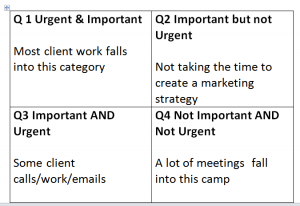Laundry: my least favorite chore, but alas it must be done if I want to wear clean clothes. Recently I was folding the mountain that had been piling up on the end of our couch when I had a revelation about time management. If I had taken the time to fold the clothes when they came out of the dryer, it would have taken less time than waiting until it piled up into an overwhelming amount of work that demanded my attention. My revelation didn’t stop there. Instead of waiting until most of our clothes need to be washed, if I run a load every day the task is more manageable and, as a bonus, we don’t run out things to wear! It all comes down to time management.

Find out what a pile of laundry taught me about time management.
From tackling laundry to writing your company’s next press release, time management is about how you choose to delegate your minutes so your responsibilities don’t collect into an overwhelming amount of work.
The Importance Of Time
So often we forget time is one of our most precious resources, and in turn waste it on activities that hold no value. Once used, time cannot be regained; there is no stopping the progression of the clock. When put into this perspective it is easy to see how important time-management skills are to helping you choose the most effective ways to invest your most precious asset and see the greatest results for your business.
Time Management In Four Steps
- Where is your time going?
Part of effective time management is knowing exactly how to use your day. You know what time you get up and when your office hours are, but have you tracked how long you spend checking email throughout the day or the time spent asking for clarification on tasks? This infographic from Atlassian illustrates how much a person’s time at work is wasted with excessive emails, meetings and interruptions, with 60% or less time actually being spent productively!
In order to see exactly where your time is being underutilized, and what times of day you work most efficiently, create a time-management journal and record your tasks from start to finish. You will be surprised by how long you spend on “quick” activities such as email. If you are not doing well in time management, you’ll notice areas that are producing little to no value to your business. By being able to see these gaps you can fit more significant assignments into your day and avoid the ones not contributing to your success.
- Prioritize your workload

Record when you start and stop activities to see where you spend your time.
One of the best ways to delegate your time into value-added activities is through prioritizing. This is not a new concept; however, determining what should be getting your immediate attention versus what can wait is a difficult skill to master. So, how do you figure out what is actually important when everything on your list seems to demand a top standing position? The first step is to write it all down. From there, you can determine what has the greatest impact on your business and goals. The items with the biggest influence should be at the top. A point of consideration with prioritizing is how the task is ranked with other parties involved. While an activity may not have a great effect on your goals, it could be a high-level priority for another person, such as a business partner or client. Clarifying the importance level with those you are working with will help you determine where the item should stand on your own to-do list.
- Create a schedule
Now that you can see where time is going and have a grasp on how to prioritize your tasks, creating a schedule is the next step. This is a perfect opportunity to grab that time-management journal you recorded activities in from step one. Using this to see when you work most productively during the day, schedule the tasks that have the most value within those productive windows and fill in the remaining spots based on priority level. Every day before you get started, create this schedule to see where your time needs to be spent. In fact, you could even do this the night before so you can jump right in the next day. By doing this every day you visualize where your time is being put, plus it will help you become more accountable on how you spend your precious resource.
- Stay flexible
No matter how much you manage and organize your time, this is life and as the saying goes, “life happens.” There are going to be events and issues that come up requiring your immediate response. Whether it’s a last-minute interview with a reporter or a negative comment on your Facebook page that you need to address right away, no amount of planning will prevent this from happening. So, what can you do? Adjust your priorities and schedule to reflect the new request. Being flexible in regards to your time management will help alleviate stress when situations arise that cause you to re-work your assignments.
Tools For Time Management
From electronic to the old-fashioned paper and pen, there are a number of tools to help you manage your time effectively; everyone has their preference on what they use, so you’ll need to find out what works best for you.
The most common time-management tool you will find is a calendar. There is nothing wrong with a paper calendar and manually entering in your day-to-day tasks; for many, the physical connection of writing helps them stay on track. If you are open to electronic calendar systems, Google Calendars are a great alternative. From being able to see multiple calendars and easily inviting others to meetings, to color coding events and setting reminders, there is a lot you can do with this option. What’s even better is that they are accessible on your smart phone and other mobile devices, making them convenient for traveling without the extra weight.
Additional time-management resources that are especially useful for busy entrepreneurs managing their company’s social media marketing are scheduling tools such as Hootsuite and Sprout Social. Both of these applications allow you to access multiple social media accounts at once and see everything there on your screen without logging in and out, saving you time and energy. A more valuable use of these time-management tools comes with their posting abilities. There are multiple options available to fit your company’s needs, from setting distribution schedules to creating your posts ahead of time to post on a specific day and time. When you have to make sure your posts are going out at a consistent time every day, scheduling your posts in advance will ease the headache of making sure you’re available and online as well as lighten your daily workload.
Take A Step Back
While you can be the superhero of your company who has mastered the art of time management, remember to take a step back and breathe when your schedule is particularly full of low-level priorities. No one can go on forever at the intense level of work that comes with high-priority tasks; burnout is far too often the result. When working on these high-level tasks WWR recommends to take a break every 75-90 minutes for roughly 15-17 minutes. This breather from your work will help you stay focused and clear your mind. If you were struggling on a task, coming back after a short breather can make all the difference, allowing you to clearly see the solution that was hiding behind the frustration before.
What should you do during a break? There are many great ways to take a break from playing a short game to going for a walk. In fact, if you work from home you could even fold a basket of laundry! The main point is shifting your attention from the work you were doing and taking a step back for a brief time.
While I am sure my family will appreciate having their clothes cleaned and folded on a regular schedule with better time management, the effects roll into managing business as well. I hope this article has helped you gain a better understanding on how to manage the tasks in your life while providing some useful time-management tools to get the most value from your efforts.
Business & Finance Articles on Business 2 Community
(45)






